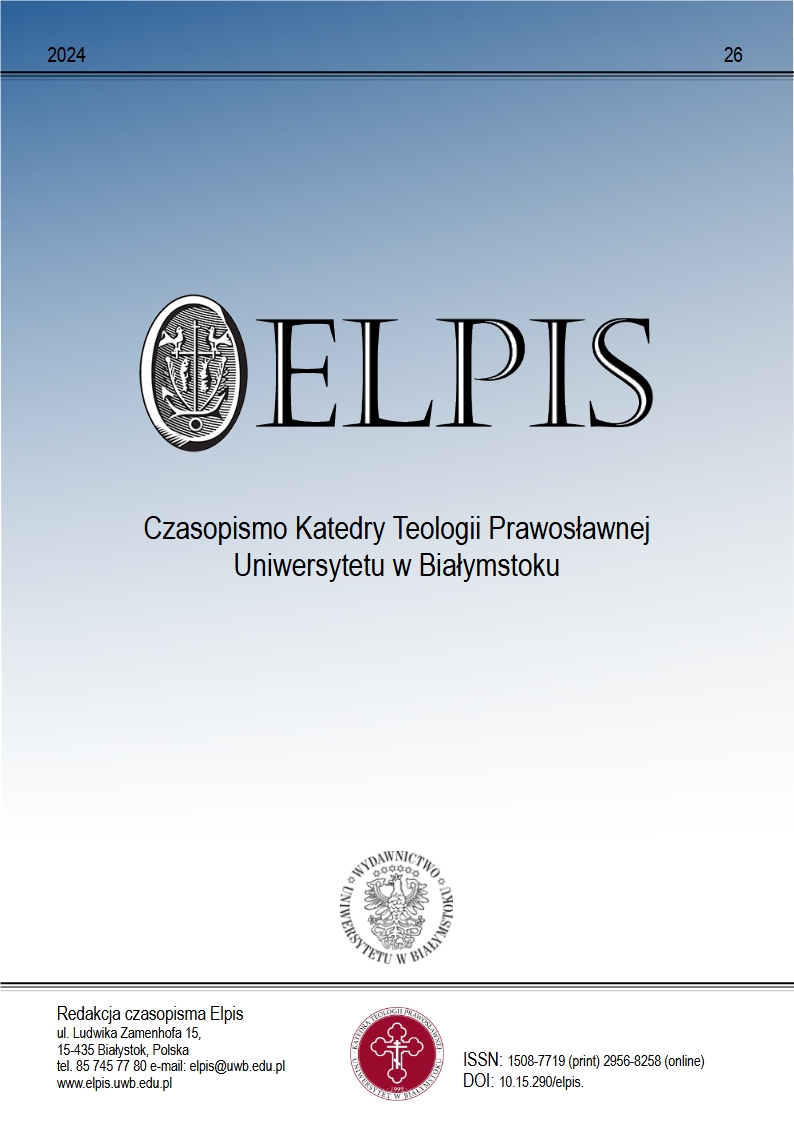Calendar reform in the Orthodox Church in Poland in 1923-1925
DOI:
https://doi.org/10.15290/elpis.2024.26.04Keywords:
Orthodox Church, calendar reform, Second Polish Republic, ecumenical patriarchate, Ministry of Religious Affairs and Public EnlightenmentAbstract
The decision to reform the calendar in the Orthodox Church was made by Ecumenical Patriarch Gregory VII. The new style was to be introduced on March 10, 1924. The patriarch's resolution was met with mixed feelings, opening a period of stormy synodal discussions in local Orthodox Churches. In Poland, the calendar issue turned into a political problem due to the intervention of government authorities in the internal life of the Church. The Orthodox population treated the above decision as a violation of religious freedoms. The lack of reception of the synodal act of April 12, 1924 regarding the adoption of a new style by Orthodox believers in Poland forced the Holy Synod to change its position on this matter. At the meeting of August 16, 1924, the Orthodox episcopate decided to repeal the previous resolution on the mandatory use of the new style wherever the faithful required it. The issue of the reform of the Church calendar has proven that when making such decisions, the Polish government and the Church hierarchy must take into account the position of the faithful. As a result, the Orthodox Church remained in the old style throughout the country, with the exception of the capital city of Warsaw.
Downloads
References
Bendza, M. (2006). Droga Kościoła prawosławnego w Polsce do autokefalii. Białystok: Wydawnictwo Uniwersytetu w Białymstoku.
Borkowski, A. (2013). Reforma kalendarza liturgicznego i jej recepcja w Kościele prawosławnym w Polsce. W: M. Kuczyńska, U. Pawluczuk (red.), Latopisy Akademii Supraskiej. Kalendarz w życiu Cerkwi i wspólnoty (t.4, s. 77-89). Białystok: Fundacja Oikonomos.
Borkowski, A. (2015). Między Konstantynopolem a Moskwą. Źródła greckie do autokefalii Kościoła prawosławnego w Rzeczypospolitej (1919-1927). Białystok: Wydawnictwo Uniwersytetu w Białymstoku.
Kostûk, V. (2000). Istoriâ Polesskoj eparhii (1922-1944), Brest: Brestskaâ oblastnaâ tipografiâ.
Kumaniecki, K. (1929). Administracja wyznaniowa. W: K. Kumaniecki, B. Wasiutyński, J. Panejko (red.), Polskie prawo administracyjne w zarysie (s. 146-287). Kraków: Księgarnia Powszechna.
Langrod, J.S. (1931). O autokefalii prawosławnej w Polsce. Studjum z zakresu polskiej polityki i administracji wyznaniowej. Warszawa: Instytut Wydawniczy „Biblioteka Polska”.
Ławreszuk. M. (2015). Wpływ lokalnych tradycji na kalendarz liturgiczny Polskiego Autokefalicznego Kościoła Prawosławnego, Elpis, (17), 121-126.
Maszkiewicz, M. (1995). Mistyka i rewolucja. Aleksandr Wwiedeński i jego koncepcja roli cerkwi w państwie komunistycznym. Kraków: Nomos.
Papierzyńska-Turek, M. (1989). Między tradycją a rzeczywistością. Państwo wobec prawosławia 1918-1939. Warszawa: Państwowe Wydawnictwo Naukowe.
Svitič, A.. (1997). Pravoslavnaâ Cerkovʹ v Polʹše i eë avtokefaliâ. W: K. Fotiev, A. Svitič (red.), Pravoslavnaâ Cerkovʹ na Ukraine i v Polʹše v XX stoletii: 1917-1950 (s. 1-231). Moskva: Krutickoe Patriarŝie Podvorʹe.
Zyzykin, M. (1931). Autokefalia i zasady jej zastosowania. Warszawa: Instytut Wydawniczy „Biblioteka Polska”.
Archeio Oikoumenikou Patriarcheiou, Kōdikas Ypomnīmatōn Eklogīs (AOP, KYE), sygn. Α/β/5; A/94.
Archiwum Akt Nowych, Ministerstwo Wyznań Religijnych i Oświecenia Publicznego (AAN, MWRiOP), sygn. 2/14/0/5/959, 1001.
Prawosławne Archiwum Metropolitalne (PAM), Dokumenty z posiedzeń synodalnych z 20.12.1924, 12.02.1925, 13.04.1925.
Downloads
Published
How to Cite
Issue
Section
License
Copyright (c) 2024 bp Andrzej Borkowski

This work is licensed under a Creative Commons Attribution-ShareAlike 4.0 International License.
The detailed terms of the CC BY-SA license (Attribution - Share Alike) are available on the Creative Commons website - link.
The author must complete and send to the editorial office (elpis@uwb.edu.pl) the completed and signed author's contract with a declaration of the originality of the article and the author's contribution to the article. Download Agreement File: HERE








